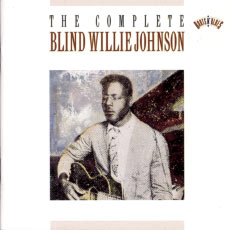In October 1990, a blues musician sold 100,000 albums in one month. This number rose to 300,000 in the Spring of 1991, and eventually exceeded one million sales. It was a feat made even more remarkable by the fact that the musician had died almost a half-century earlier, after having recorded only 29 songs (and 12 alternative versions) in 1936 and 1937. As you might have guessed, the musician is Robert Johnson, the star of country blues, also known as traditional blues. His anxious songs and magical guitar playing were highly influential toward the works of artists such as Clapton, the Stones and Led Zeppelin; his song Sweet Home Chicago became a hit for the Blues Brothers. He is also the man responsible for putting the Devil and the crossroads into blues legend. Some original recordings by the artist were released during his lifetime: a dozen 78rpm records on the label Vocalion. 50 years later, a new means of recording arrived on the scene and swept away all that preceded it, the 33rpm vinyl and the cassette. These two formats were then followed by the compact disc, the CD. It was thanks to a collection recorded on this format (The Complete Recordings) that Robert Johnson would exceed a million sales. It’s strange how the most modern technology can enable the rediscovery of some of the world’s oldest music. Such a rediscovery was not a first for the bluesman as his music had already undergone a renaissance in 1961 thanks to the compilation King of the Delta Blues, released on the 33rpm LP, a format which came to replace, after many years, the older 78rpm record. By the way, the term “hi-fi” was conceived in 1934.
To summarize this story of physical formats: the CD replaced the 33rpm LP, which replaced the 78rpm record (which itself replaced the cylinder). None could outlive the blues. And since we’re looking at the question of how technology influenced a resurgence of old blues, let us first look back at the history of sound production. In his book, The History of Records and Sound Recording (Carnot, 2004), Daniel Lesueur explains how in 1548 in Pantagruel Rabelais imagines the sound of battle being trapped in ice during the winter and released in spring when the ice melts. In 1656, Cyrano de Bergerac dreamed of “a miraculous book with no pages or words. At last, a book where learning only requires one’s ears.” To trap sound and reproduce it, like photography traps light, had been a fantasy that became a reality in the final third of the 19th century, with the invention of the phonograph and the gramophone.
The history of blues has many chapters. That which is of interest to us today is “country blues”, blues which originated from rural areas. A lot of anglophones name it according to time rather than place, calling it “pre-war blues”. Not Star Wars or the Gulf War, but the Second World War. Such was its golden age. But how did blues before the First World War sound? No one knows as it was never recorded. Before records, music was diffused in the form of sheet music and songbooks. Blues very much existed before blues records and was played by wandering musicians in the countryside, small towns, and sometimes railway platforms, of the southern United States. It was there that in 1903, while waiting for a train on the platform of Tutwiller station in Mississippi, William Christopher “W.C.” Handy discovered blues. Next to him on the platform, a black man in rags whose toes stuck out of his shoes, played the guitar while pressing a knife on the strings – a Hawaiian style that was popular at the time.
Born in the South and the son of emancipated slaves, W.C. Handy was a composer and musician. He went on to write the blues he had heard on the platform at Tutwiller station onto sheet music mixing in his own ragtime and jazz compositions to create a more fashionable sound. And so, the “father of blues” was born along with famous songs such as Saint-Louis Blues and Memphis Blues. In the 1910s, songs were composed with blues in their name such as Dallas Blues by Hart Wand in 1912, and The Weary Blues by Artie Matthews in 1915. However, such songs were not blues, and were more instrumental ragtime pieces than traditional oral country blues songs. To listen to one of the first sung records labelled “blues”, one must look to 1920 and Mamie Smith's Crazy Blues which sold 1 million copies in six months. A beautiful, old-fashioned jazz track accompanied by as brass orchestra; Crazy Blues was still not an “authentic” rural blues song. Mamie Smith was a comedian, dancer and jazz singer who lived in Harlem. The same goes for Working Man Blues by Joe “King” Oliver, recorded in 1923 in Chicago with Louis Armstrong in the orchestra. Today we would call such music “urban”.
Create a free account to keep reading





